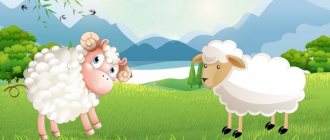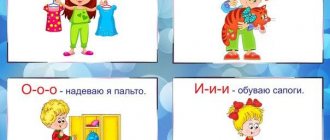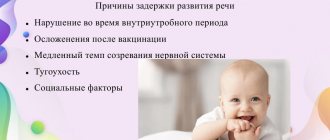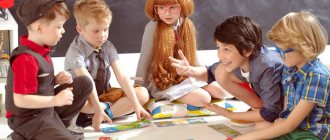Why do you need finger gymnastics?
A set of games and exercises aimed at developing fingers, fine motor skills of the arms, hands, and psychological processes is represented by finger gymnastics. Classes relax, prepare you for school, improve communication with peers, and distract you from unpleasant moments. On the pads of children's fingers there are many nerve endings, the stimulation of which leads to the activation of brain activity. It has been proven that gymnastics and massage affect the development of speech, psychological processes, and writing skills.
Gymnastics goals for children of primary preschool age (1.5-3 years):
- child speech development;
- stimulation, training of the articulatory apparatus;
- developing the skill of tracking an object;
- development of psychological processes;
- rhythm training;
- improving coordination of movements;
- practicing the skill of correctly repeating the actions of other people.
In middle preschool age (4-5 years), gymnastics allows you to:
- relax tension in the muscles of the arm and hand;
- form psychological processes;
- improve fine motor skills of the hands;
- develop involuntary attention;
- stimulate the speaking process, enrich the child’s vocabulary.
For older preschoolers (5-6 years old), finger games help:
- prepare the child for school;
- stimulate cognitive activity;
- develop fine motor skills of the hands, which has a positive effect on preparation for writing;
- enrich the child’s vocabulary;
- develop the creative abilities of the baby.
Finger Theater
Finger theater is an exciting game that:
- Stimulates the development of fine motor skills;
- Introduces the child to the following concepts of shape, color, size;
- Helps develop spatial perception (the concepts of “right”, “left”, “next to each other”, etc.);
- Develops imagination, memory, thinking and attention;
- Helps develop vocabulary and activates speech functions;
- Forms creative abilities and artistic skills;
- Introduces basic mathematical concepts.
For children aged 1 – 2 years (using the example of the fairy tale “Kolobok”):
- First, introduce your child to the characters in the fairy tale. Invite your child to look at and touch the figures. Then put each character on your finger in turn and describe it.
- Introduce your child to the name of each finger on his hand. For example, you can say this: “I have a Kolobok sitting on my index finger.”
- Then act out a fairy tale for your child. Place the characters on your fingers and cross your arms. Start telling the story, raising your fingers with the characters as the action progresses. For example, the fairy tale “Kolobok” can be told as follows. Thumbs up with Grandma character. Tell your child that today this hero will bake Kolobok. Rhythmically tap the heels of your palms against each other without releasing your fingers. At the same time, say: “Grandma is kneading the dough.” Using the same principle, play up the appearance of each character.
For children aged 2 – 4 years (using the example of the fairy tale “Kolobok”):
- Ask your child if he remembers the fairy tale “Kolobok”. Remind him if necessary.
- Then ask your child to place the characters on the table in the order they appear in the story. At the same time, ask to characterize each of them according to the principle: “Grandma is old, kind, caring; Kolobok is round, ruddy, mischievous,” etc.
- Ask your child questions about the fairy tale. For example: “Why did grandma decide to bake Kolobok? Why did he leave his grandmother and grandfather? Who did he meet on the way?
- Then act out a fairy tale in front of the little spectator using a finger theater.
- At the end, ask your child to act out a fairy tale in front of you using a finger theater. If necessary, prompt him.
How to properly exercise with your baby
Finger exercises for the development of speech and thinking can be done at home. The work will be easier for the baby in the presence of a loved one. Sometimes preschoolers are afraid to make the wrong movement with their hands, to complete the task incorrectly, so they work inactively during gymnastics in kindergarten. It is important to do gymnastics at home, taking into account the age characteristics of the child.
Complex for children from one to 3 years old
Finger exercises and games are especially useful for children of primary preschool age. Classes contribute to the active formation and launch of speech. Kids like to repeat the movements of adults; they listen carefully to the rhymes and songs that accompany the exercises. You can use a special speech therapy file in the game.
When conducting home exercises, you must follow the following rules:
- For children of primary preschool age, the first lessons should last no more than 1 minute, then 3-5 minutes each.
- The parent should praise the child for his successes and not scold him if he repeats the adult incorrectly.
- To make the games fun and interesting, you should use finger exercises that correspond to the age characteristics of the baby.
- For games, it is important to use songs and rhymes that the child could then repeat after an adult; they should be small and easy to understand.
- Exercises should be selected according to the degree of difficulty: start with simple ones, moving on to more complex ones.
The following complex develops the child’s speech, psychological processes, and fine motor skills of the hands.
Complex for children 4-5 years old
Gymnastics in middle preschool age is important for speech development; during this period, the baby begins to actively speak and expand his vocabulary. Normally, by the age of 4, a child should know up to 3,000 words, actively use them in conversations with adults and peers, and construct sentences correctly. Children aged 4-5 years involuntarily try to memorize poems and songs that accompany finger games, which stimulates the development of mental processes. In middle preschool age, finger gymnastics helps to correlate a word with an action, relieves tension after modeling or drawing.
Middle-aged preschoolers like exercises where they need to sing a song, learn a rhyme, and repeat after an adult. In kindergarten, during play, special attention is paid to how the baby listens and perceives the task and remembers it. The following materials can be used to conduct classes:
- cards with objects, natural phenomena, figures, etc.;
- diagrams or pictures with finger movements drawn;
- illustrations mentioned in the rhyme: animals, clothes, furniture, etc.;
- presentations to recreate a visual image.
Speech development will be facilitated by exercises where the child will need to repeat movements and words after an adult. Children 4-5 years old like to play shadow theater when they need to depict animals or plants. You can stage small productions with the children based on the fairy tale you have studied.
Complex for children 5-6 years old
Playing finger games and doing gymnastics with children of senior school age is useful as preparation for school. It is easier to master writing if fine motor skills are actively developed at home and at school. It is difficult for first-graders to relax the muscles of their hands and fingers, which provokes difficulties in writing simple calligraphic elements.
You can play with preschoolers, relying on the knowledge acquired in kindergarten: counting, colors, shapes, etc. Children like the finger game “Twister”, when you need to place your fingertips on the color that appears in the cubes. To play you will need 2 cubes, one with a color palette, the second indicating the desired finger, a multi-colored sheet in the form of circles. You can arrange competitions, study together with your parents or peers.
Exercises are used for the active work of individual fingers and their joints.
When working with older preschoolers, you can use not only exercises and games, but also special massage balls. They train the muscles of the hand and relax it. It is important to roll the object not only on the palm, but also separately on each finger, connecting them together with a ball.
It is important to observe the time frame and combination of exercises when working with children of any age. To make the process of learning and development easy and interesting for the child, you need to carry out exercises for no more than 5 minutes, alternating them with rest or self-massage of your fingers and palms.
Games and gymnastics are recommended for all preschoolers for all-round development, stimulation of speaking, creative activity, and communication skills. It is especially important to conduct classes at home, not only in a preschool institution, if the child is lagging behind in speech development. Repeated repetition of rhymes and songs during exercises and games leads to their memorization. Later, the child begins to repeat after the adult either individual words or the entire poem.
Passive gymnastics (massage)
It is better if an experienced professional shows you the massage technique, but you can master the simplest techniques yourself.
The massage is performed with one hand, the other holds the massaged hand. Session duration: 3 – 5 minutes; carried out several times a day.
Massage includes the following types of movements:
- Stroking - performed in different directions;
- Rubbing - differs from stroking with a greater force of pressure (the hand does not slide over the skin, but moves it);
- Vibration - applying frequent blows with the tips of half-bent fingers;
- Massage using a special ball - with the ball you need to make movements in a spiral from the center of the palm to the tips of the fingers; practical advice: you need to use a hard ball, that is, it should not be easily deformed (then the impact will be maximum);
- Flexion-extension of the fingers - the fingers are initially clenched into a fist, each in turn is extended and massaged from the side of the palm in a circular motion from the base to the tip.
We talk more about massage here.
Finger games for speech development
The essence of the finger motor skills lesson is to teach the child to use his fingers to depict some objects or living beings. In this case, all finger movements must be explained to the baby. This will help the child understand concepts such as “top”, “bottom”, “right”, “left”, etc. After the child learns how to do the exercises himself, you can try to act out scenes or short fairy tales, distributing the roles among yourself and your little actor (for example, a meeting between a hedgehog and a bunny in the forest). Here are some examples of such exercises.
- Finger game\
- . The index and middle fingers are straightened, the rest are clenched into a fist. Little man. “Run” with your index and middle fingers on the table.
- Finger game\
- . Clasp your hands, straighten the fingers of one hand and the thumb of the other. Cat. Connect the middle and ring fingers with the thumb, raise the index and little fingers up. Horned goat. The index and little fingers are straight, the thumb is on the bent ring and middle fingers. Butterfly. Cross your hands at the wrists and press your palms with the backs of your hands facing each other, fingers straight; palms with straight fingers make slight movements in the wrists - “butterfly flies.” Glasses. Fold the fingers of your right and left hands into rings and bring them to your eyes.
In addition to these examples, you yourself can come up with many interesting and entertaining exercises for your child to develop speech.






